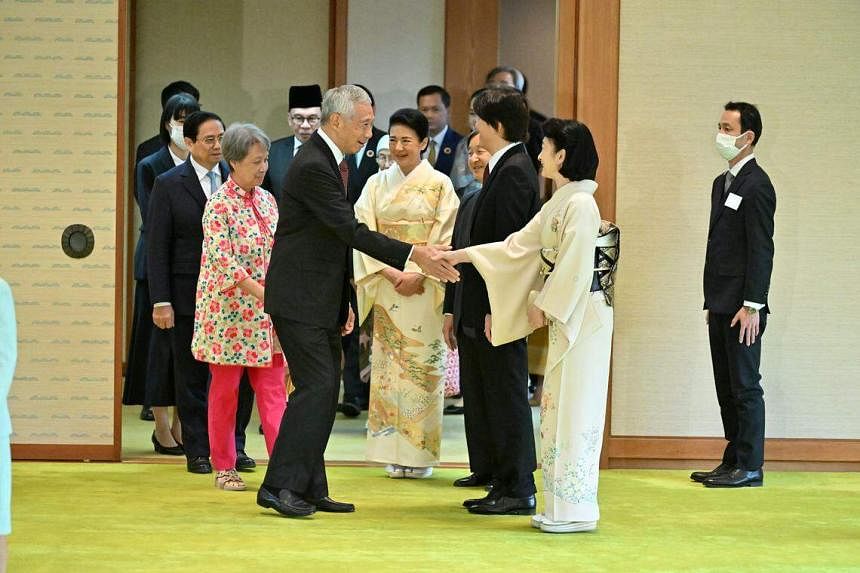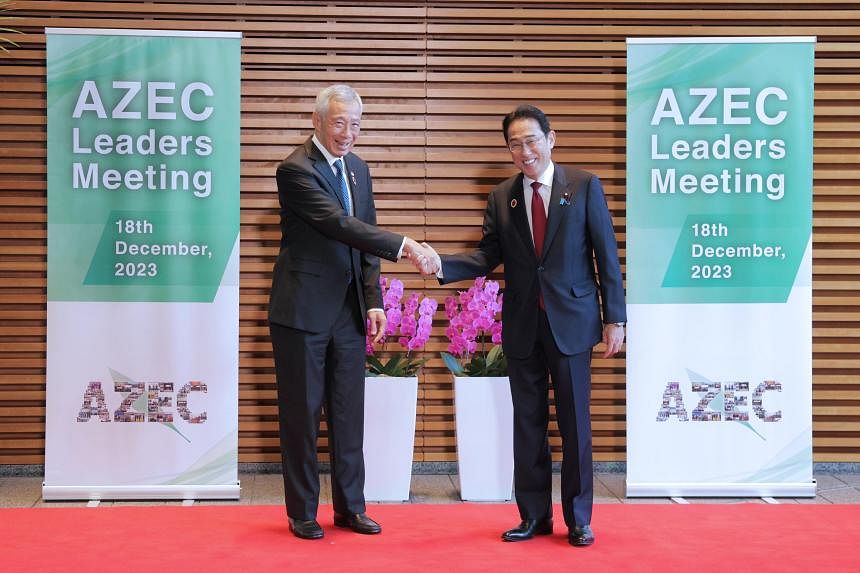TOKYO – Singapore is fully behind Japan’s efforts to include sustainability issues as part of its diplomacy, Prime Minister Lee Hsien Loong said on Dec 18.
Speaking to the Singapore media at the end of his visit to Tokyo, PM Lee described the Japan-led Asia Zero Emission Community (Azec) initiative as a “footprint of countries” it wants to cooperate with on green issues.
The core principle of Azec is that there is no one-size-fits-all formula to decarbonisation, given unique national circumstances, and advocates customised pathways to enable countries to cut carbon emissions.
“(Azec) includes all of the Asean countries except Myanmar, and adding in also Australia. So it’s the footprint of countries they want to cooperate with on green and sustainability issues as part of their diplomacy. And it’s something which we fully support,” said PM Lee.
The framework comprises elements such as green hydrogen, infrastructure for sustainable energy and the financing of sustainable energy, he told reporters.
“These are all things which Singapore will need to look to, if we are going to reach net zero in 2050,” he said. “It’s going to be a very big challenge, it’s not at all a straightforward matter, and it’s still a work in progress. But we’ve set a goal, and we will do our best to work towards it.”
The Azec held its first leaders’ meeting earlier on Dec 18, the last day of a three-day gathering of South-east Asian leaders in Tokyo to mark a half-century of Japan-Asean relations.
PM Lee told reporters that the COP28 climate conference in Dubai, which ended on Dec 12, had set “the right direction for the world” with its statement on transitioning away from fossil fuels.
This, he said, was a clear message that the world must become less reliant on fossil fuels by developing renewables and other new sources of energy.
Earlier at the Azec meeting, PM Lee had welcomed Japan’s leadership and said the initiative has “created opportunities for members to discuss, conceptualise and collaborate on new decarbonisation initiatives, and to build up capabilities for the green transition”.
Stressing the need for cooperation to speed up the global transition to net zero, he said: “No country can go it alone, nor can governments by themselves make it happen.”
This is especially important given that decarbonisation projects are capital-intensive, he said, with promising technologies still needing much more research and development investment before they can be deployed at scale.
“We know first-hand the existential threat that climate change poses,” he told the meeting. “When it comes to climate change, only by working together can we get to net zero.”
Japanese Prime Minister Fumio Kishida said that Azec’s aim was to attain the “triple breakthrough of simultaneously achieving decarbonisation, economic growth and energy security”.
To this end, Japan will take the lead to develop new technologies and legal systems in promising areas such as perovskite solar cells, offshore wind energy, hydrogen energy, and carbon capture and storage, Mr Kishida said.
There are more than 350 projects in progress between Japanese companies and Azec member countries. Japan is also supporting the training of about 8,500 people across Azec member countries on energy transition.
Mr Kishida announced that Japan will issue 1.6 trillion yen (S$15 billion) of what he said was the world’s first sovereign “climate transition bonds” from February 2024. He also unveiled plans for a new Asia Zero Emission Centre, to be set up at the Jakarta-based Economic Research Institute for Asean and East Asia think-tank, as a control tower to discuss technical cooperation and promote policy coordination.
Estimating that decarbonising Asia would require 4,000 trillion yen, Mr Kishida said: “Azec will create a new, large decarbonisation market in Asia that will attract capital from around the world.”
During PM Lee’s visit, Japan and Singapore agreed on a Green and Digital Shipping Corridor, through which Singapore will work with six of Japan’s busiest ports to decarbonise and digitalise the maritime industry. Among other things, it will involve pilot projects to test the use of zero- or near-zero emission fuels such as ammonia and hydrogen. The port authorities will also look into ways to mitigate cyber-security risks and streamline port clearance processes.
Bilateral relations between Singapore and Japan are strong, PM Lee said, pointing to close political, economic and policy coordination including in the digital and green economies.
Noting that Japan is Singapore’s largest Asian investor, and Singapore, Japan’s, he made reference to a wide diversity of Singaporean investments that range from real estate to venture capital, services and education.

Security engagement and arms race
Digitalisation and the environment are among many areas of collaboration between the two countries, and PM Lee said on Dec 17 that Singapore was keen to deepen cooperation with Tokyo to promote peace and stability.
When asked by the Singapore media on Dec 18 if a stronger Japanese defence presence might inadvertently cause an arms race that destabilises the region, PM Lee said: “Now, nearly 80 years after the end of the war, the situation has evolved. Japan has changed and has a contribution to make.”
He noted that Japan is both a security ally of the United States and a member of the Quad, together with the US, Australia and India.
But he added that Japan also wants to maintain stable ties with China and work with the region to foster security in the Indo-Pacific.
Japan has thus been actively participating in avenues such as regional defence forums, and PM Lee said there was “no reason Japan should not take an active role and contribute its views”.
“There is a cooperative element to this,” he said, adding that the competitive element resulting in military build-ups is driven by “strategic rivalries rather than regional issues”.


